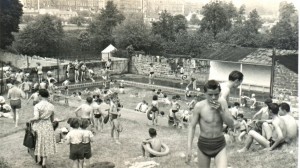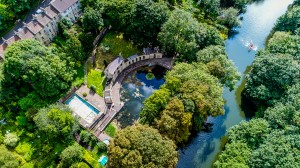The Bristol office of specialist construction group Beard has started restoration work on the UK’s oldest surviving public lido, the Cleveland Pools in Bath – following a 17-year community campaign to save the Grade II* listed site.
The pools, pictured, were built in 1815 and are now regarded as a nationally significant site.
The restoration project has the support of hundreds of people in Bath, many of them with happy memories of summers spent poolside or learning to swim in the pools.
Beard’s work should be finished by summer next year, making the pools accessible for all, both physically and financially, for the first time since 1984.
It was used as a trout farm for a short time and later threatened with demolition before the Cleveland Pools Trust was formed in 2004 to rescue it from dilapidation.
However, the £8m project poses some significant engineering challenges for Beard as the site is only accessible from the nearby River Avon for the machinery, building materials and equipment required to carry out the major refurbishment work.
The firm will use the nearby Avon Rugby Club site to load the material and equipment onto a on a pontoon to be pushed upriver by a barge fitted out for the purpose.
Swindon-headquartered Beard, which opened its Bristol base in 2015, has extensive experience in the heritage sector.
The 128-year-old, family-owned firm’s high-profile contracts Bristol have included demolishing and replacing the outdated toll booths at Clifton Suspension Bridge and building the SS Great Britain’s £7.2m Being Brunel museum and visitor experience in the city’s historic dockyard.
Anna Baker, project director at Cleveland Pools Trust – the group that successfully campaigned for the site’s reopening – said: “After years of community action, starting construction work is a hugely significant moment which we’re all so happy to see.
“We’ve had fantastic support to get us this far, particularly from our main funder, the National Lottery Heritage Fund, but still have some way to go with £400,000 still to raise.
“Beard has brought a great deal of expertise to the project and a real appreciation of what the facility will be used for once it’s complete, which is very important for us in a construction partner.”

The work includes the restoration of two pools – the crescent-shaped main pool and a smaller, shallower child’s pool, pictured.
The largely unaltered Grade II* listed buildings will also be restored and the central cottage upgraded to become the main entrance and pay point, with a caretaker’s flat on the a first floor.
Other work will include creating a terrace seating area with shelter, new toilets and showers and refreshment kiosk along with a new river pontoon for access via boat services to Pulteney Bridge, improved disabled access including an electric buggy to manage the steep entry slope, and a heritage exhibition and learning space.
Work is due to be completed in time for swimmers to return next summer, for the first time since it was forced to close in 1984. And for the first time the pools will be accessible for all, both physically and financially.
Beard project manager Mark Tregelles said there have been some unusual logistical challenges in terms of accessing the site and starting the job.
He said: “We recognise how culturally significant this development is for the community, and wider region, not only as a listed building but also as a space for the community to use and enjoy when it’s complete.
“We are working closely with the Cleveland Pools Trust to realise its vision to make it an accessible and fun place to be for all users, and also to reflect the rich history behind the nationally important site.
“But it is certainly a different prospect for Beard, as we’ve had to do a lot of work in preparation to establish a base down river at Avon Rugby Club, which we will use as a loading site to get everything we need onto the barge and sailed up to the site.
“There can’t be many building projects today which require access by boat. So, we’re pleased to be starting after months of planning, and to draw on years of experience working on culturally important buildings to ensure delivery on time for the community.”
The project was set to start in March last year. But the pandemic led to delays and increased costs – from £6.2m to £8m for the period 2019 to 2025. However, in recent months the project has gained national support with additional funding from the National Lottery Heritage Fund, the DCMS Capital Kickstart Fund and emergency grant aid from Historic England.
The project includes a community engagement and volunteering programme with dedicated resources to deliver an activity plan aiming to engage a wide and diverse section of the local community in meaningful projects.
So far this has included giving students the experience of working on a real project, running intergenerational activities about the history of the pools and engaging volunteers to create a walking trail to the site as part of a green travel plan.
The start of work has been welcomed by Bath Preservation Trust. Trustee Victoria Thornton OBE said “We are delighted to see that many years of dedication, perseverance and hard work and has paid off.
“As work begins on site this week BPT congratulates the team for reaching such an important milestone. The historic Pools will once again be a wonderful asset to the city.”































